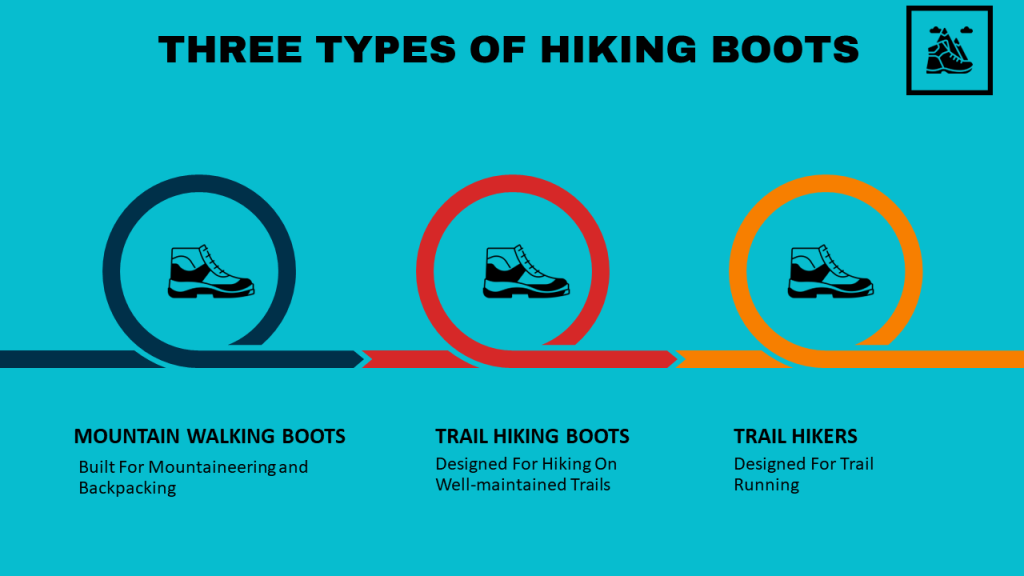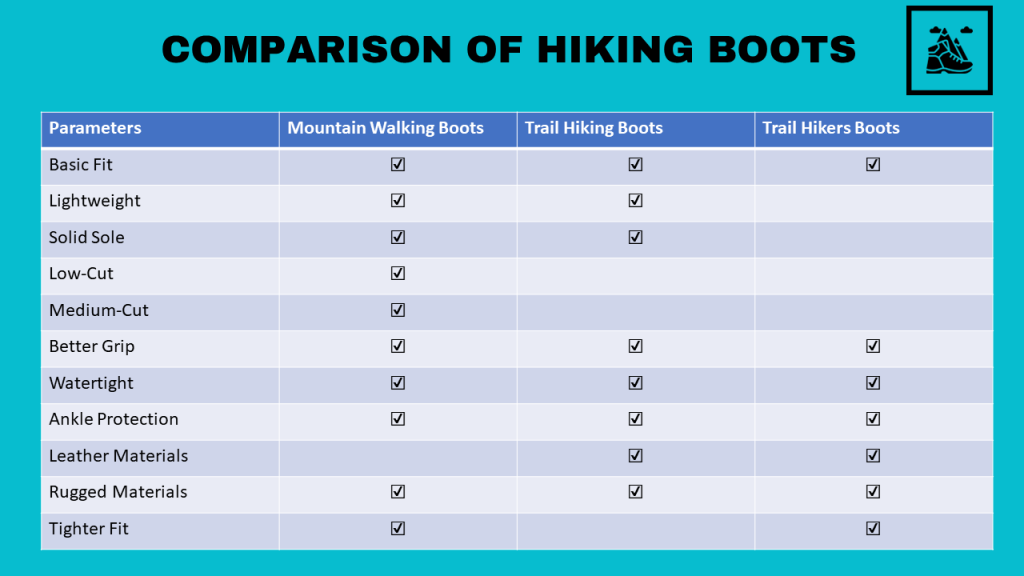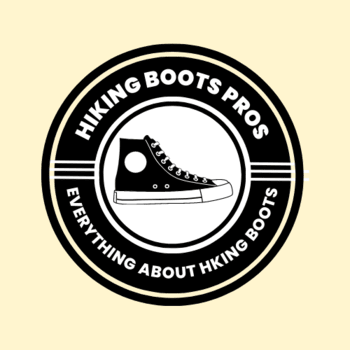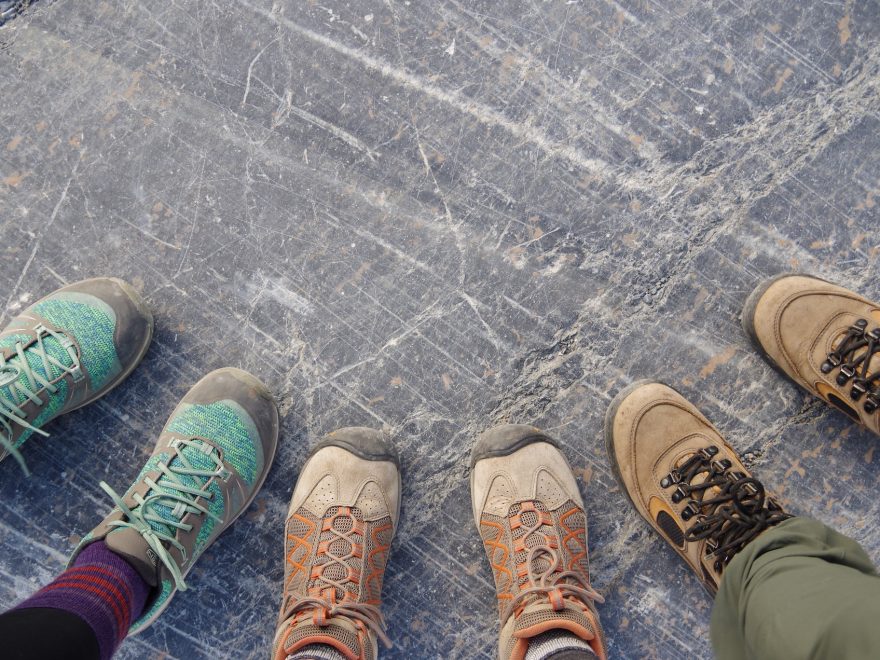Last updated on May 5th, 2023
Hiking is great for nature and fitness, but ensure you’re well-prepared.
One of the most crucial pieces of gear for any hiker is a comfortable pair of hiking boots. These are essential due to their support, stability, and protection from rugged terrain.
Not all hiking boots have the same construction. Different types are available for specific activities, terrains, and weather conditions. It’s essential to understand the types of hiking boots. This helps to pick the best-suited hiking boots for your needs.
In this blog post, we’ll be discussing the three main types of hiking boots: hiking shoes, day hiking boots, and backpacking boots.
This blog post covers the three main types of hiking boots. They are hiking shoes, day hiking boots, and backpacking boots.
The blog post details the construction, materials, and support. At the end of this post, you’ll have a better understanding of each type of hiking boot.
So, whether you’re planning a day hike, a weekend backpacking trip, or a thru-hike, we’ve got you covered. Let’s dive into the world of hiking boots and find the perfect pair for your needs.
What Are the Three Types of Hiking Boots?
Are you a hiking enthusiast looking for the perfect pair of boots? There are three main types of hiking boots in the market. They are mountain walking boots, trail hiking boots, and trail runners. Each has unique features and benefits to meet your specific needs.
Mountain Walking Boots
Mountain walking boots are built for mountaineering and backpacking. They provide excellent ankle support, are waterproof, and are durable. These boots are made for long treks in rugged terrain.
Trail Hiking Boots
Trail hiking boots are designed for hiking on well-maintained trails. They provide ample ankle support and are more lightweight than mountain walking boots. They are great for day hikes and shorter backpacking trips.
Trail Hikers
Trail hikers are the most lightweight and flexible of the three types of hiking boots. The hiking shoes designed for trail running provide less ankle support.
These are better than mountain walking or trail hiking boots. Trail hikers are perfect for shorter hikes or runs on well-maintained trails.
When choosing hiking boots, consider the terrain you’ll be hiking on. This will help you know the required amount of ankle support. Look for boots with durable materials and good traction.
Investing in high-quality hiking boots can improve your comfort and safety while hiking.

How Three Types of Hiking Boots Different?
Are you a fan of hiking, but find yourself confused about the different types of hiking boots? Don’t worry, I’ve got you covered! Let’s start with mountain walking boots.

Mountain Walking Boots
These mountaineering boots feature a solid sole for better grip. They also support rugged terrain.
The mountain walking boots made of synthetic materials are durable. These boots might be heavier compared to other hiking boots. But they are lightweight in nature.
Basic Fit
Mountain walking boots have a basic fit with a high cut. It provides excellent ankle support when it comes to a comfortable fit. They’re also waterproof, keeping your feet dry during wet weather conditions.
Lightweight
Trail hiking boots designed for day hikes have a low-cut or medium-cut design. It has lightweight materials construction making it comfortable and easy to move in.
Trail hiking boots that offer ankle support and are best for dry weather conditions.
Omit, it’s important to choose the right type of hiking boots based on your hiking needs. The mountain walking boots are perfect for hiking in wet conditions.
But if you’re planning a day hike on a well-maintained trail, trail hiking boots will be the perfect fit. Focus on fit and durability for a comfortable hiking experience.
Solid Sole and Synthetic Materials
Mountain walking boots designed for mountaineering offer excellent support and durability. It also provides protection from rugged elements. They have a basic fit that is roomy enough to accommodate thicker socks for insulation.
These boots are also often lightweight to help with high-altitude climbing. The sturdy sole offers an excellent grip on rocky surfaces, and synthetic materials are used to provide durability and water resistance.
Low-Cut Hiking Boots
Low-cut Trail Hiking Boots are ideal for hikers who want a balance of support and flexibility. They are also lighter and more breathable than Mountain Walking Boots. The lower cut of the boot provides more freedom of movement, but it also means that there is less ankle support. These boots are often made of waterproof materials to keep your feet dry in wet conditions.
Medium-Cut Hiking Boots
Medium-cut trail hiking boots offer more ankle support than low-cut boots. This makes them a better choice for individuals with ankle problems. They are also more supportive on uneven terrain. These boots have a waterproof membrane to keep your feet dry.
Trail Hiking Boots
Trail hiking boots designed for trails offer better grip and ankle protection. The watertight design helps hikers traverse through varied terrain and weather conditions.
Better Grip
Trail hiking boots designed with a specialized sole offer improved traction. It is beneficial on the ground on uneven or slippery surfaces. This is important to prevent slips, falls, and injuries while hiking on a trail. The sole has deeper lugs, which are the bumps on the bottom of the shoe, that provide traction and stability.
Watertight
Trail hiking boots designed to keep your feet dry even in wet and damp conditions help you with comfort. The boots have waterproof materials construction such as Gore-Tex is a breathable membrane. It helps to keep the water out while allowing your feet to breathe. This is important because wet feet can cause discomfort, blisters, and even hypothermia.
Ankle Protection
Trail hiking boots offer ankle support and protection. This is crucial for hiking on uneven terrain. They’re higher cut than regular hiking shoes, offering added ankle stability and support. This reduces the risk of twisting or spraining your ankle while hiking.
Trail hiking boots are comfortable and durable. These boots help hikers tackle challenges and are protective.
Trail Hikers Boots
Are you ready to hit the trails? If so, you’re going to need a good pair of hiking boots, and trail hiker’s boots are an excellent choice. Boots designers create hiker’s boots for hiking on rugged terrain. This helps to hike on uneven terrain, making them great for outdoor activities.
Leather Materials
First up, let’s talk about the materials used in Trail Hikers Boots. Many boots in this category have Nubuck leather or Split-Grain leather construction. Nubuck leather is full-grain leather has a soft and velvety texture.
It’s also more breathable than other types of leather, making it perfect for long hikes. Split-Grain leather is a durable option that’s made from the lower layers of cowhide. It’s tough and long-lasting, making it an excellent choice for rugged terrain.
Rugged Materials
Speaking of rugged terrain, that brings us to our next subtopic: rugged materials. Trail Hikers Boots can take on challenging conditions and come out on top.
The materials used in these boots, such as rubber and high-density nylon are durable. They are able to withstand the toughest of hikes. They are also waterproof, so your feet stay dry even in the wettest conditions.
Tighter Fit
Trail hiker’s boots have a tight fit. The tight fit provides support and stability on uneven terrain. It also prevents foot injuries by wearing loose-fitting shoes.
Another great feature of trail hiker’s boots is their durability. They can withstand wear and tear. The boots are suitable for rocky and rough terrain. These boots are a long-lasting investment for any hiker.
Trail hiker’s boots made from high-quality materials are durable. The materials include Nubuck and Split-Grain Leather helps to improve support and stability.
Invest in trail hiker’s boots to get a comfortable and safe experience on trails. The boots are suitable for day hikes and multi-day backpacking trips.
What Other Types of Boots Are for Hiking?
Are you looking for a hiking boot that can withstand any terrain and weather? Look no further! While we’ve already discussed three types of hiking boots, there are a few other types to consider.
Strong Sole
A strong sole is a must-have for any hiking boot. A thick and sturdy sole with deep treads can provide excellent traction. This helps to stay stable on uneven terrain.
Waterproof
Waterproofing is another key feature to look for in a hiking boot. Wet feet can ruin a hike, so having a waterproof membrane or coating can keep your feet dry and comfortable.
Stability
Stability is important for preventing ankle injuries while hiking. Look for boots with a supportive ankle collar and a sturdy design to keep your feet stable and secure.
Durability
Durability is a must for any hiking boot. You want a boot that can withstand the wear and tear of long hikes and harsh conditions.
Toughness
Toughness is an essential feature of any hiking boot. The boot should be able to handle rough terrain. This protects your feet from hazards such as rocks and branches.
When searching for the perfect hiking boot, keep in mind these factors. A strong sole, waterproof, stable, durable, and tough are important features. Happy trails!
What Makes Hiking Boots Comfortable?
Hey, there fellow hikers! Are you tired of sore feet and blisters ruining your hiking trips? One of the most important factors to consider when choosing hiking boots is comfort. Let’s explore what makes hiking boots comfortable.
First, it’s all about finding the right fit. Hiking boots should fit but not too tight, and leave enough room for your toes to wiggle. A comfortable fit will help prevent blisters and foot pain during your hike.
Another important factor to consider is the type of material used in the boots. Leather and synthetic materials are popular choices for hiking boots. This is important to choose a material that is breathable. It provides adequate support for your feet.
Comfortable hiking boots also have good shock absorption. This helps reduce the impact on your feet when walking on uneven terrain. A well-cushioned midsole and insole can make a big difference in the level of comfort.
Don’t forget to break in your hiking boots before hitting the trails. Wearing them around the house or on shorter hikes will help mold the boots to your feet. This makes them more comfortable.
In conclusion, comfort is key when it comes to hiking boots. Comfortable fit and breathable materials can make your hiking experience easy.
Good shock absorption can make your hiking experience enjoyable. So, choose your hiking boots and have a happy, comfortable hike!
Which Is the Lightest Hiking Boot?
Are you looking for a hiking boot that won’t weigh you down on the trail or break the bank? Look no further! In this blog, I’ll share my top pick for the lightest hiking boot that won’t hurt your wallet.
When it comes to hiking, having comfortable and lightweight boots is essential. This makes a successful trip. There are many lightweight options on the market, and one of my top picks is the TFO Hiking Shoes.
These shoes have less than $50 price. The design is for easy walking making them perfect for shorter backpacking trips. The EVA midsole and mesh upper provide breathability and support.
Not only are these shoes lightweight and affordable, but also come with a durable rubber sole. This provides excellent traction on various terrains.
The TFO Hiking Shoes are a fantastic option for lightweight footwear. These are comfortable, and affordable hiking boots.
Don’t let heavy and uncomfortable boots slow you down on the trail. Give these a try and experience the freedom of easy and comfortable hiking!
Conclusion
In conclusion, when it comes to hiking boots, there are three main types. They are Mountain Walking Boots, Trail Hiking Boots, and Trail Hikers Boots.
Each type is able to handle specific terrain and weather conditions. So, you need to choose the right hiking boot for your needs.
There are other types of boots like approach shoes and backpacking boots. These are also suitable for hiking, and they offer their own unique features and benefits.
When shopping for hiking boots, comfort is crucial. Look for boots with features like cushioned soles and breathable materials. These have good ankle support to keep your feet happy on the trail. If you need the lightest boot, consider materials like mesh and synthetic leather.
Investing in a good pair of hiking boots is essential for any outdoor enthusiast. With the right pair, you’ll be able to explore the great outdoors with confidence and comfort.
FAQs
The most suitable hiking footwear for day hikes is trail hiking shoes or low-cut hiking boots. For challenging hikes, mid-cut hiking boots are most suitable.
Hiking boots and trekking boots are similar in many ways, but there are a few key differences. Hiking boots are generally designed for day hikes or shorter trips. They are often lighter weight.
Trekking boots are generally designed for more challenging trips with heavier weights. They are also water-resistant and often feature features like crampon compatibility for mountaineering.
Hiking boots should fit but not be too tight or too loose. A good fit is essential for comfort, support, and preventing blisters. Hiking socks can help make your feet fit without slipping.

Tyler Looney is an avid hiking enthusiast and the author of HikingBootsPros.com, a website dedicated to providing helpful insights and advice on choosing the best hiking boots. His expertise and passion for hiking have made him a valuable resource for both beginner and experienced hikers alike.

